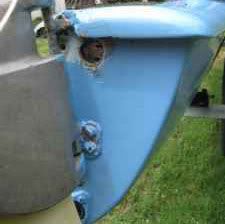|
It can be done but the picture is vague. Can you take the rudder off and post some better pictures?
West System epoxy is the way to go. You can use epoxy resin on polyester but not polyester resin on epoxy. How close are you to a West Marine? They usually carry a small epoxy repair kit in a clear plastic clamshell package. Judging by your first picture, it should do what you want.
Tip time.
You want a box of rubber gloves, plastic mixing buckets(glue doesn't stick to plastic after it kicks off therefore reusable), scrap pieces of plywood, a puddy knife, Bondo type squegee, heavy plastic, blue 3m tape, duct tape, acetone, orbitalsander/sanding block, sand paper(40, 60, 80, 120, and then finer), 5200 by 3M, and WD-40.
Prep the area with ductape and trim with 3M tape. That will keep the drips or stray glue under control.
About west system it comes in kick off times. Fast, slow, tropical(xtra slow),etc. The hotter the air temperature, the slower the resin. Stay out of the sun and glue around 10am; the boat's surface will have warmed up by then. That way, after you are done, the night air doesn't restrict curing time. It'll stay tacky. The additives to the resin is glass filler(chopped fiber glass for fill) and tiny glass bubbles(for sanding/fairing). You mix the resin and hardener(easy ratio to mix) then mix in the additive. It should mix up to thick enough that you can work but not dry. Spread it on a scrap piece of plywood and apply using a puddy knife and a squeegee. Keeping the spread low will keep it from kicking off. If it does, you'll smell it. If you use it then, it will have tiny holes after it cures and will be weak. If you smell it, drop it. It gets very hot.
It will work just like mudding drywall. Use the filler mix to just fill the hole leaving a small divot. You can clean it up with acetone soaked on a rag. Acetone or laquer thinner cleans up epoxy. After that cures, scratch it with heavy grit sandpaper. Mix up a batch of epoxy with, this time, glass bubbles and a little bit of filler to hold shape. Think of Marshmellow cream. The more filler you have in it the harder it will be to sand. Touching up with acetone will make sanding easier. Gluing is easy. Sanding is a Bi!*&.
After fill, one night cure, glass bubble spread, and one night cure, you should be ready to sand. Orbital sanders work great but don't stay in one spot. Keep it moving; side-side, up-down,etc.
You can lightly mist it with black spray paint for a guide coat. Sand with 120, 220, fine as you want to go. When the black paint is gone, it should be smooth/fair enough. Take the tape off.
Paint or gel coat happens here. After the glue has cured, it's hard as a rock and you should have no problem drilling pilot holes for gudgeon screws. Coat the screw with 5200 and screw gudgeon on. Cleaning up 5200 is a snap. What doesn't WD-40 do? WD-40 and a paper towel will do fine.
If you need to use fiberglass cloth, lay it on clear plastic and drizzle straight epoxy spreading with a brush. Paint a little epoxy where you are going to apply then, pick the cloth up, and put it on. Squeegee off the air bubbles. Grind it smooth after curing overnight and use the glass bubble mix for fairing.
Est time:
Prep area 30 mins
mix couple of mins
apply 10-15 mins
wiping a few mins
clean up 5 mins
cure time 8 hours+
Sand a little bit with 60 grit 15 mins
Glue with glass bubbles same amount of time
Guide coat less than 2 seconds
Saaaannnnddddiiinnnggg coarse, medium, fine, a handful of hours.
You get the picture...
I've worked with fiberglass more days than I would like to say so if you need clarification let me know. If not, I know who to call. But I don't have enough practice with gel coat. Can't help you with that.
From one Carolinian to another, Good luck!
|












.jpg/CNCmoM4BIAEgAiADIAQgBSAGIAcoBw/NZLhBctISadOkzCaQjlY2rMmJqn-C5YEwNbJlsWk3II?size=1024x768&size_mode=2)